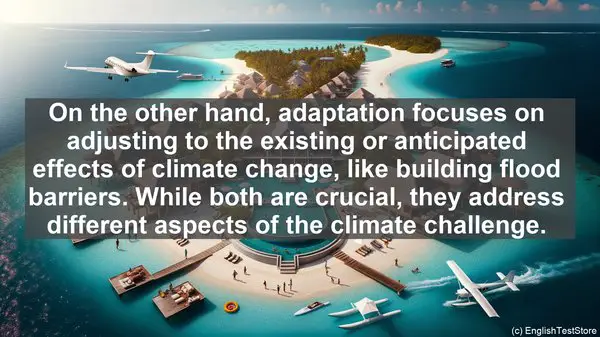Introduction
Today, we’re going to dive into the world of climate policy. As you explore this field, you’ll come across numerous terms that may seem similar but have distinct meanings. In this lesson, we’ll unravel the confusion surrounding 10 such words. So, let’s get started!
1. Mitigation vs. Adaptation
Often used interchangeably, mitigation and adaptation are two distinct strategies in climate policy. Mitigation refers to actions taken to reduce greenhouse gas emissions, such as transitioning to renewable energy sources. On the other hand, adaptation focuses on adjusting to the existing or anticipated effects of climate change, like building flood barriers. While both are crucial, they address different aspects of the climate challenge.
2. Renewable vs. Sustainable
Renewable and sustainable are often used synonymously, but they have subtle differences. Renewable refers to resources that can be naturally replenished, like solar or wind energy. Sustainable, however, encompasses not just the renewability but also the long-term environmental, social, and economic viability of a practice or resource. So, while renewable energy is a vital part of sustainability, it’s not the sole factor.

3. Carbon Footprint vs. Carbon Offset
Your carbon footprint is the total amount of greenhouse gases, primarily carbon dioxide, emitted directly or indirectly due to your activities. It’s a measure of your impact on climate change. Carbon offset, on the other hand, involves compensating for your emissions by supporting projects that reduce or remove an equivalent amount of greenhouse gases. It’s a way to balance out your carbon impact.
4. Paris Agreement vs. Kyoto Protocol
Both the Paris Agreement and the Kyoto Protocol are international treaties aimed at addressing climate change. The Kyoto Protocol, adopted in 1997, set binding emission reduction targets for developed countries. In contrast, the Paris Agreement, signed in 2015, is more comprehensive, involving both developed and developing nations. It focuses on limiting global temperature rise and enhancing climate resilience.
5. Climate Change vs. Global Warming
While often used interchangeably, climate change and global warming have distinct meanings. Global warming specifically refers to the long-term increase in Earth’s average surface temperature. Climate change, on the other hand, encompasses a broader range of effects, including shifts in precipitation patterns, sea-level rise, and more frequent extreme weather events. Global warming is a component of climate change.

6. Carbon Sink vs. Carbon Source
A carbon sink is any natural or artificial reservoir that absorbs more carbon dioxide than it releases. Forests, for example, act as carbon sinks. In contrast, a carbon source releases more carbon dioxide than it absorbs. Fossil fuel combustion, for instance, is a significant carbon source. Balancing and expanding carbon sinks while reducing carbon sources is crucial for climate stability.
7. Resilience vs. Vulnerability
In the context of climate change, resilience refers to the ability of a system, be it a community or an ecosystem, to withstand and recover from disturbances. Vulnerability, on the other hand, signifies the degree to which a system is susceptible to harm or damage. Enhancing resilience and reducing vulnerability are key aspects of climate adaptation strategies.
8. Greenwashing vs. Sustainability
Greenwashing refers to the deceptive practice of presenting a company, product, or policy as more environmentally friendly or sustainable than it actually is. It’s a form of marketing manipulation. Sustainability, on the other hand, involves genuine efforts to minimize environmental impact and ensure long-term viability. Greenwashing undermines the credibility of sustainability initiatives.
9. Decarbonization vs. Carbon Neutrality
Decarbonization involves reducing or eliminating carbon dioxide emissions, primarily from fossil fuel use. It’s a crucial step in combating climate change. Carbon neutrality, on the other hand, goes beyond just reducing emissions. It means achieving a balance between emitted and removed carbon dioxide, often through carbon offsetting. It’s a more comprehensive goal.
10. IPCC vs. UNFCCC
The Intergovernmental Panel on Climate Change (IPCC) and the United Nations Framework Convention on Climate Change (UNFCCC) are two key bodies in the global climate governance. The IPCC is responsible for assessing scientific information on climate change, while the UNFCCC is the parent treaty that guides international climate negotiations. They work in tandem to inform and shape climate policy.
